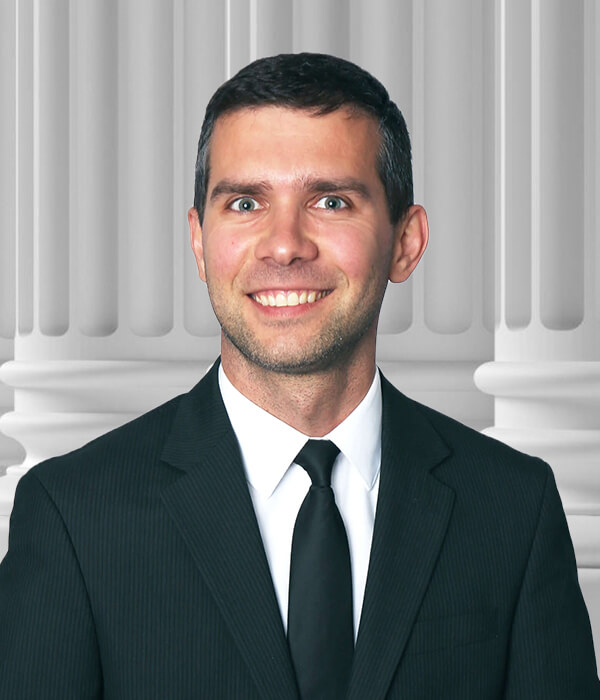
Partner
Roger Emerson
Areas of Practice
Intellectual Property (patents, trademarks, copyrights, trade secrets)


Patents help encourage innovation and entrepreneurship across all industries. When you’ve developed a valuable new invention, you want to know that you alone can benefit from it or choose which individuals or organizations can utilize it. At Emerson Thomson Bennett, we understand the importance of protecting your intellectual property. We provide a range of patent prosecution services to help you obtain a patent that gives you control of your invention.
Once an invention has been conceptually developed, the first step of the process is to conduct a patent availability search. We have access to a database that encompasses issued patents and published patent applications from the United States and around the world. We will review your invention in light of the existing technology and determine whether or not your invention is patentable. While a patent availability search is not required, we believe it is valuable and highly recommend it.
A product clearance search is similar to a patent availability search. However, instead of attempting to determine the patentability of an invention, we conduct a search of the relevant patent references to determine if a particular product or service might infringe an existing patent. A product clearance search is recommended prior to the launch of a new product.
Patent infringement occurs when someone makes, uses, sells, offers for sale, or imports in the United States a product or service covered by an in-force, issued U.S. patent. An infringement/noninfringement opinion is a formal opinion on whether or not a particular product or service infringes an issued patent. We review the entire communication (“prosecution history”) between the inventor and the U.S. Patent and Trademark Office, the issued claims, and the relevant case law to determine the scope of the claims. We will then analyze the product or service to determine if it is covered by the claims.
A patent validity/invalidity search and opinion is conducted to determine whether an issued U.S. patent is valid. We review the patent in question, then conduct a search of the relevant issued patents and published patent applications from the United States and internationally and provide an opinion on the strength of the patent in question.
A provisional patent application allows filing without some of the formalities of a utility or “regular” patent application. This enables an inventor to quickly establish a filing, or priority, date for their invention. It also allows the term “Patent Pending” to be applied. Provisional patent applications are never examined by the United States Patent and Trademark Office and expire 12 months from the filing date.
A utility, or “regular,” patent application is the application that may issue a United States patent. A patent gives you the right to exclude others from making, using, offering for sale, or selling your invention in the United States, or importing your invention into the United States. A utility patent application can be filed on a useful process, machine, article of manufacture, or composition of matter. Once filed, the patent application is examined by an examiner at the U.S. Patent and Trademark Office, usually between 12 and 36 months after filing. For most applications, the examiner will reject the claims in a first Office Action. The patent attorney will then provide arguments and/or amendments to the claims to convince the examiner to issue a patent. Once a U.S. patent is issued, it is in force for twenty years from the earliest filing date, subject to the payment of three maintenance fees.
Design patent applications are filed to protect new, original, and ornamental designs for an article of manufacture. An example would be a tread design on a shoe. Design patent applications consist almost entirely of drawings, with very little description. Design patent applications are examined relatively quickly and are frequently granted within one year of filing. A design patent is in force for 15 years from the issue date, with no maintenance fees required.
Plant patent applications are filed to protect new, distinct, asexually reproduced varieties of plants. Once a plant patent issues, it is in force for 20 years from the earliest filing date, subject to the payment of three maintenance fees.
The PCT (Patent Cooperation Treaty) is a treaty between most developed nations. The treaty is designed to harmonize patent laws between member countries and to make it easier for an inventor to obtain worldwide patent coverage. At the present time, over 150+ countries have joined the PCT. It provides a unified procedure for filing patent applications to protect inventions in each of its contracting states. A single filing is made with a Receiving Office (RO) in one language. This results in a search performed by an International Searching Authority (ISA), accompanied by a written opinion regarding the patentability of the invention. A PCT application does not itself result in the grant of a patent. In other words, a PCT application, which establishes a filing date in all contracting states, must be followed up with the step of entering into national or regional phases to proceed toward the grant of one or more patents.
A patent issued in the United States only gives the owner the right to exclude others from making, using, offering for sale, or selling your invention in the United States or importing your invention into the United States. If you want to protect your invention in other countries, you must file patent applications in those countries. One route is to file a PCT patent application, as noted above. The other route is to file directly in foreign countries. We have connections with colleagues in most countries to aid in filing foreign patent applications.
Our firm is well-situated to aid non-U.S. counsel in filing applications in the U.S., either directly from non-U.S. applications or through the national phase of a PCT patent application. We are interested in establishing reciprocal relationships with non-U.S. firms.
Obtaining a patent for your invention may not be all that is needed to keep it out of the wrong hands. Our litigation practice focuses on protecting our client’s intellectual property rights and includes patents, trademarks, trade secrets, unfair competition, copyrights, and Internet and domain name disputes. We represent companies and individuals, and plaintiffs and defendants.
Our firm has experience in licensing the intellectual property rights of our clients, including patents, trademarks, trade secrets, and copyrights. We have experience in both drafting and enforcing license agreements.
When you have an impressive invention, you deserve to profit from it. To get the most out of your invention, a patent is necessary to give you exclusive rights to it. Without this, others can reap the benefits of your hard work and talents. Emerson Thompson Bennett is dedicated to protecting our clients’ IP in the U.S. and abroad. Our patent prosecution team will work diligently with you to determine the best route to ensure your invention is protected.
Contact us online today to schedule a meeting with our attorneys, or you can reach us by phone at 330-434-9999.

Intellectual Property (patents, trademarks, copyrights, trade secrets)



Intellectual Property, Patent, Trademarks, Copyright, Litigation Research



Intellectual Property, Patent, Trademarks, Copyright



Intellectual Property, Patent, Trademarks, Copyright, Internet Law, Litigation, Licensing



Intellectual Property Litigation, Patents, Trademarks, Copyrights


Akron Office
1914 Akron-Peninsula Road
Akron, OH 44313
Wedgewood Office Park
3841B Attucks Drive
Powell, OH 43065-6082
Phone:
330-434-9999Fax:
330-434-8888
"*" indicates required fields